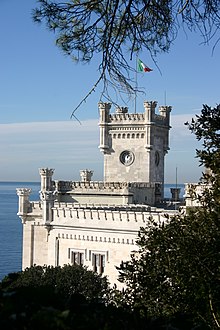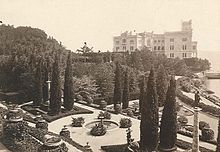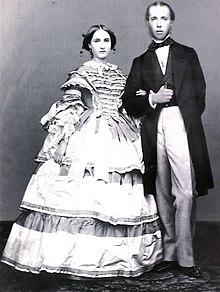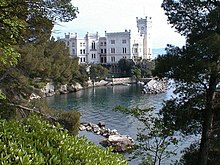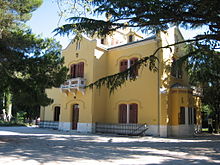Miramare Castle

Miramare Castle ( Castello di Miramare in Italian ) is located on a rocky cliff in the Bay of Grignano on the Adriatic Sea, about five kilometers northwest of the Italian port city of Trieste . The city of Trieste and its surroundings came to the Habsburg Monarchy as early as 1335/1382 and remained Austrian until 1918. During this time, the spelling of Miramar Castle was .
The castle was built between 1856 and 1860 for Archduke Ferdinand Maximilian of Austria , the brother of Emperor Franz Joseph I , and his wife Charlotte of Belgium . The architect and site manager was Carl Junker . The castle and its interior as well as the surrounding park were built according to the detailed instructions and ideas of the Archduke and in many areas they reflect Maximilian's great love for the sea. The name Miramar or Miramare is based on the Italian / Spanish expressions Mira (from the verb “mirar”, meaning “to look” or “to look”) and Mare (“sea” in Italian), which means roughly a view of the sea . The interior was not completed until 1870, after the death of Ferdinand Maximilian. The castle has been open to visitors as a state museum since 1955.
history
Building history
When Archduke Ferdinand Maximilian of Austria , the brother of Emperor Franz Joseph I , was appointed Commander-in-Chief of the Austrian Navy in 1854 , he settled in the port city of Trieste , which at that time belonged to Austria , and rented the Villa Lazzarovich on the San Vito hill.
In 1855 Maximilian decided to have his own residence built on a rocky promontory near Grignano , along with an extensive park in the surrounding area. The Viennese architect and builder Carl Junker , who had recently completed his work on the railway in Trieste and was involved in the construction of the Vienna water pipeline in 1870, was commissioned with the planning . Junker submitted a design for a villa-like building that already had the characteristics of today's castle. Since Maximilian the result was not extensive enough, he initially rejected the plans and commissioned another architect, Giovanni Berlam from Trieste . In his design, he worked out a medieval country house with pinnacles and turrets. Maximilian also rejected these building plans and finally decided on a second design by Carl Junker, which was based on his first plans, but had given the originally villa-like structure a monumental size with three floors and a mezzanine .
On March 1, 1856, construction of the castle began. In the spring of 1857 Maximilian was appointed Governor General of Lombardy-Veneto . Although he was living in Milan at the time with his wife, Princess Charlotte of Belgium , Maximilian often traveled to Trieste to follow the construction work on the castle and to give instructions. In 1858 the client decided to forego one floor, so that the castle only consisted of the ground floor, first floor and mezzanine, and the proportions of the building were underlined. At this point in time, the Austrian decorator Franz Hofmann and his son Julius were already working on furnishing the living and sleeping rooms of the archducal couple, which were implemented according to Maximilian's precise instructions and ideas.
When Lombardy was lost in 1859 as a result of the Austrian defeat in the Battle of Solferino , Maximilian and Charlotte withdrew to Trieste. Since the interior of the castle was not yet finished, the couple temporarily moved into the summer house in the park of Miramare. At Christmas 1860, the couple finally moved to the main building.
In 1863 Maximilian was in Miramare Castle at the instigation of the French Emperor Napoléon III. appointed Emperor of Mexico by a Mexican delegation . When he traveled to Mexico with Charlotte the following year, construction work on the interior of the palace and on the park was still ongoing. With a firm conviction that he would return to Trieste, Maximilian continued to take care of his building project and sent written instructions to Hofmann. He had detailed plans for the palace park made by his gardener and botanist Wilhelm Knechtel , who accompanied Maximilian to Mexico.
After Napoléon III. had withdrawn his troops from Mexico and Maximilian had been left alone in the fight against the revolutionary powers of the country, Charlotte traveled to Europe to, among other things, with Pope Pius IX. To find support. During her visit to Rome , the empress showed the first signs of mental confusion and was then imprisoned in Miramare's summer house. After Maximilian's execution in 1867, Charlotte's condition worsened. At the instigation of her brother Philipp of Belgium , she had to leave Miramare and was housed in Château de Bouchout in Meise , Belgium . Charlotte never returned to Miramare.
The state rooms on the first floor of the palace were not completed until 1870, three years after Maximilian's execution.
Summer residence of the Habsburgs (1867–1914)
After the death of Maximilian and the return of the mentally confused Charlotte to Belgium, the castle became a summer residence of the Habsburgs .
In September 1882, Emperor Franz Joseph I stayed in the castle on the occasion of the 500-year period of Habsburg rule over the city of Trieste . His wife Elisabeth , his son and heir to the throne Rudolf and his daughter-in-law Stephanie of Belgium were with him . Elisabeth and Stephanie also resided at the castle in the following years. Between 1869 and 1896, Empress Elisabeth stayed in Miramare several times. Stephanie, who was also a niece of Charlotte , spent a few days at the castle in August 1885. On March 22, 1900, she married the Hungarian Count Elemér Lónyay in the castle chapel . The Austrian heir to the throne Franz Ferdinand of Austria-Este and his family as well as the last Austrian Emperor Karl I and his wife Zita were among the other guests of the palace .
The castle after 1914
After the outbreak of the First World War , the entire furniture was brought to Vienna and stored in Schönbrunn Palace and Belvedere Palace. Due to an agreement between Italy and Austria , the castle furnishings were completely brought back between October 1924 and March 1925 to restore the castle's original interior. The castle was finally opened to visitors on March 24, 1929.
Between 1932 and 1937 Amadeus of Savoy , 3rd Duke of Aosta, lived with his family in the rooms on the first floor of the castle. From 1943 to 1945 the castle was occupied by German troops and then used as the Allied military headquarters until 1954. The castle has served as a museum since 1955. The state art collection of Miramare includes works by the Italian painters Francesco Guardi (1712–1793) and Cesare Dell'Acqua (1821–1905).
architecture
facade
The facade of the castle is made of white limestone from neighboring Istria and is a typical example of romantic historicism . The architect Carl Junker combined neo-Gothic style elements with neo-medieval forms such as round arches. The Vienna Arsenal , built by Theophil von Hansen between 1849 and 1856 , and the Lloyd arsenal in Trieste, built between 1853 and 1857, served as models for the construction of the palace .
Interior
The castle consists of a ground floor, first floor and a mezzanine floor under the roof ( mezzanine ). The interior of the building, which was implemented by decorators Franz and Julius Hofmann on the instructions of Archduke Maximilian , is also a combination of different styles. The archducal couple's private living rooms and bedrooms were furnished between 1858 and 1860 in neo-Gothic and neo-medieval styles. The state rooms, on the other hand, were not completed until 1870 and have elements of the neo-renaissance and neo-baroque styles that were typical of the period of the Second Empire .
Park
In addition to the castle, the extensive gardens that surround it are also famous. The park extends over 22 hectares on what was originally a barren ledge. Archduke Ferdinand Maximilian wanted to transform this bare rocky hill into a garden and botanical research institute. According to his wish, the park should above all become a place for meditation, where nature and art come together in harmony. For this reason, under the direction of court gardeners Josef Laube and Anton Jelinek, part of the park was laid out as an Italian garden and the other as an English park .
The geometric flower beds of the Italian garden indicate the dominance of humans over nature. However, nothing of this is currently noticeable because they are being completely renewed (including the boxwood edging) in order to remove damage mainly caused by severe fungal infestation. The Trieste Monument Protection Office also decided to charge an entrance fee for visiting the park in early 2015 at the latest in order to use it for the maintenance of the park. The English park area, mainly laid out as a forest, is a typical natural landscape. In addition to the native Mediterranean vegetation such as laurel bushes , cypresses , myrtles and elderberries , the park contains a large number of exotic plants (including some very rare specimens) that the Archduke considered from his travels Admiral of the Austrian Navy brought such. B. a ginkgo tree from China , a coastal sequoia and bamboo trees .
Until a few years ago there was a monument to Maximilian in the park, which was created by the sculptor Johannes Schilling at the instigation and under the direction of Baron Pasquale Revoltella, inaugurated in 1875 by a committee in Piazza Giuseppina (today Piazza Venezia) in Trieste and later in the palace gardens was relocated. The more than nine meters high bronze monument shows Archduke Ferdinand Maximilian in a vice admiral's uniform. His gaze and hand were on Miramare Castle. The statue stands on a pedestal adorned with allegorical figures and reliefs. They symbolize the power of the House of Habsburg and Maximilian's philanthropy as well as his interest in science and art. Before 2009, the monument was transferred from the palace gardens to Piazza Venezia.
Garden shed
In the park is the Castelletto ( small castle ), which was intended as the couple's residence during the construction work on the castle and was later used as a garden house. It later became a prison for Charlotte after she lost her mind following her husband's execution in Mexico. Today the nature conservation organization WWF is located in the rooms of the castle.
Other facilities
In addition to the park (with its own entrance), there are two scientific research institutes on a shared campus: the International Center for Theoretical Physics (ICTP) and the Scuola Internazionale Superiore di Studi Avanzati (SISSA).
Individual evidence
- ↑ Tourists and citizens want to save Miramare Castle. In: kurier.at. November 26, 2012. Retrieved December 23, 2017 .
literature
- Franz Weller: The imperial castles and palaces in words and pictures. Hof-Buchdruckerei, Vienna 1880. ( Online )
- Eliana Perotti: The Miramar Palace in Trieste (1856–1870). Böhlau, Vienna et al. 2002, ISBN 3-205-77014-5 .
- Fiction
- Karl May uses the castle as a place for the action in part of his colportage novel The Way to Happiness (Collected Works Vol. 78: The Riddle of Miramare ).
Web links
- official homepage
- The Imperial Castle of Miramar - The Castle Park
- The Empress in Miramar .. In: Die Presse , September 6, 1876, p. 9, center left. (Online at ANNO ).
Coordinates: 45 ° 42 ′ 9 ″ N , 13 ° 42 ′ 46 ″ E

